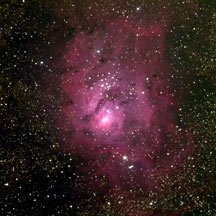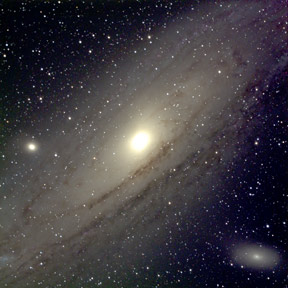AstroPhoto Trip to Locatelli Ranch
- Aug 1, 2008
Shahram and I converged on Friday
evening Aug 1 at our Locatelli Ranch roadside site for some astrophotography.
I packed up the 8" f/4 and also the Megrez and also both GM8's and the
ST2000xcm for Shahram. I planned to use the ST4000xcm for the first time - its
maiden voyage. Well, I forgot my laptop. Rather than drive back home to get
it, we teamed up and just used the 8" w/ ST4000xcm. Skies were crystal
clean but not pitch dark as there was no fog to block Silicon Valley or Santa
Cruz lights. The ST4000xcm worked great, although I was suprised it would not
cool down below a rather warm -13C. The ambient temperature was in the low 60's
or high 50's - warm in other words. Still, I'm used to operating the ST2000xcm
at -20 to -40C. Is the ST4000xcm only a single-stage TE cooler? I'm trying to
find out. But the images looked very low noise in CCDOPS despite the higher-than-I'm-used-to
chip temperature. The seeing was poor, and focusing was frustrating. The stars
show a big PSF, not the fault of the new camera. I'm thinking more seriously
about getting our Moonlight focuser motorized, with a remote. Only a single
10min dark was used.

The Lagoon Nebula. 5x10min
stack using sRGB+gamma. No cropping. Registax 4 single-star stacking.
Photoshop and Astronomy Tools tricks as per usual.
|

The Andromeda Galaxy. 6x10min
stack using sRGB+gamma. No cropping. This was in the northeast, right
over Silicon Valley. I'm really impressed! The stars are better focused
here, and this image compares pretty well to a similar
scale image with the Megrez taken from pitch black skies
near Bridgeport in the Eastern Sierra. In fairness, the Megrez shot
is with an 80mm f/6 instead of an 8 f/4, and is only 30min instead of
1 hour here.
|
|
|
My preference is to not adjust the
image in CCDOPS or in Registax, but to save all adjustments for Photoshop. So
in CCDOPS I left the color balance at zero, left the default "x shift"
box checked, and used sRGB+gamma, saving at TIFF format. Then...Registax 4 on
my laptop seemed to have real trouble stacking the 6 M31 images. I ended up
stacking 3 and then the other 3 and then stacking the two 3-stacks, using only
a single reference star. That went without incident. Memory I suppose, as the
ST4000 images are 8meg each; although I've got 1GB in my laptop. Anyway, Registax
4 is a fantastic program but it does seem to need several attempts before it
gets a good stack. In Photoshop, I first used Astronomy Tool Actions: 2x 'make
stars smaller', 'enhance contrast', 'noise reduction'. In CS2: levels, adjusting
only the gray level in order to bring out the dim outskirts, altered the color
balance towards the blue to correct for reddening due to the relatively low
altitude, unsharp mask, color saturation slightly. Finally, I 'saved for web'
using 96 pixels/inch and sizing for a 1024x768 view screen and saving as a .jpg
with moderate compression. I like to keep images to less than 200k to minimize
view download time.

